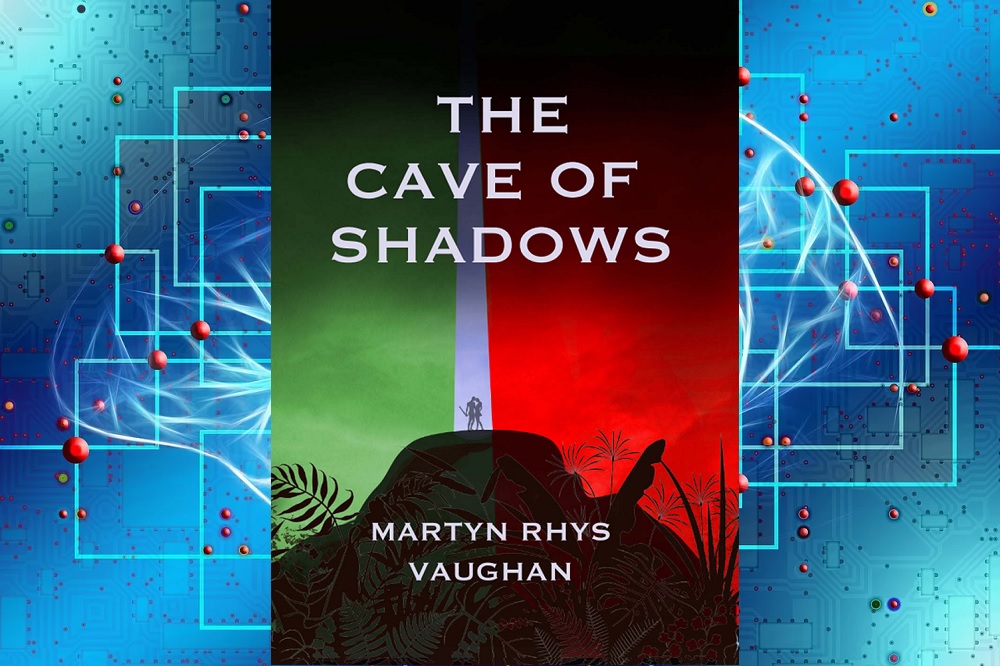Review: The Cave of Shadows is a brave undertaking shot through with big ideas

Jon Gower
In an essay written in the mid 1970s Isaac Asimov offered this definition: ‘Science fiction can be defined as that branch of literature which deals with the reaction of human beings to changes in science and technology.’ While there are many definitions of the genre, this one, by the hyper-prolific author of book series such as ‘The Robot’ and ‘The Foundation’ serves as a clear and useful entry point to ‘The Cave of Shadows.’
For there’s an awful lot of technology on display in this novel by the author of ‘Domains of Darkness’ and ‘Quantum Exile,’ such as a panoply of arms from different period such as ancient swords, modern hand grenades and, in the future, interstellar ram jets. The book is underpinned by a lot of serious science, as is true for much of the best sci-fi, which had this reader Googling terms such as “Hohmann transfers” and “hard radiation.”
Martyn Rhys Vaughan is himself a statistician, so facts are a tool of his, and you also can see the influence of his boyhood passion for books by H. G. Wells such as ‘The Time Machine’ and ‘The War of the Worlds’ in the plausible if unsettling futurology at work in this novel.
It’s the story of the adventures of what we can loosely describe as a man and a woman, Jon and Shana (they become more human-like as their story unfolds) as they journey in search of their own origins and in passing try to solve the not-so-small matter of something being wrong with the universe, things being out of kilter. They also question whether they themselves exist during a wild journey during which come across the Gate of Light, encounter arachnoid creatures, some armed with flailing knives, and get caught up in the struggle between Protectorate, with its dark-side-of-the-force unquenchable thirst for conquest and the fate of the doomed Degenerates who are hunted as prey.
This all takes place against a vivid set of backdrops, for Jon and Shana adventure under skies which can only be described as lysergic, a kaleidoscope of colours such as crimson, scarlet, cerise and veridian, under which they encounter the obsidian-faced Lords of the Sands or the palindromically named Zarka and Akraz and Korok, the latter being the central nemesis of the plot and a form of mind control, to boot.
Speculation
This is a universe where reality is a shifting, mutable thing and the existence of clones serves to confuse everyone about who’s who. The central conceit or question of the book perhaps is inherent in the title, referring to Plato’s idea that we are but shadows projected on the wall of a cave.
So Jon and Shana get their hands on “visualizers” or VR gadgets which allow people to see all manner of things, including some visions which sound like the common fate of humanity: “There was a feeling of crisis in the way the ant-like communities were behaving. There was tumult in the streets beneath the tall buildings. Some groups were using violence against other groups. There were flames on the buildings, the boxes on the roads stopped moving, huge numbers of people were on the move, some coming to the great villages but more going out, in great waves of desperation.” Sounds familiar?
Martyn Rhys Vaughan provocatively explores matters of mind and matter further, suggesting that if it were possible to transform all the data from the neural networks of an organic brain into digital form might it not be possible to do this the other way around? In fact, the book is shot through with such big ideas and big questions and in that sense it’s a bold and brave undertaking.
The book picks up pace throughout and toward the end is hurtling along at speeds unguessed at by our physics, that is until Einstein came along. It is never less than entertaining, but the fact that the speculation is set squarely within the realms of possibility means that a book which at first seems like science fiction melding with fantasy might actually be a guidebook, a guidebook to chaotic times ahead, even if they’re very, very, very far ahead.
The Cave of Shadows by Martyn Rhys Vaughan is published by Llyfrau Cambria Books, costs £9.99, and can be bought here.
Support our Nation today
For the price of a cup of coffee a month you can help us create an independent, not-for-profit, national news service for the people of Wales, by the people of Wales.






Welsh Sci-fi characters, where are they? James T. Kirk followed in the foot steps of Dan Dare and Flash Gordon: action heroes, self confident and assured in the values they were spreading round the galaxy. Compare and contrast with Dr Who, who until plot development revealed him as a “Time-Lord”, was a Victorian time traveller re-invented for a post-imperial England: an eccentric, a bumbler struggling at times even to fly his time-ship, yet somehow it was credible that he could overcome armies of high tech fiendish foes armed only with a sonic screwdriver (I’ve always thought Boris Johnson would make… Read more »